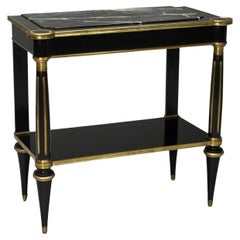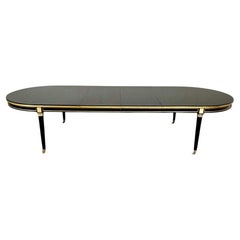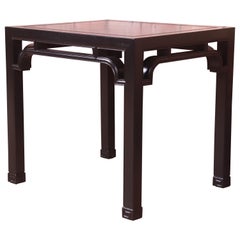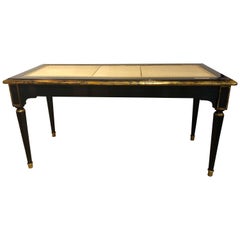Hollywood Regency Black Lacquer Tables
Vintage 1960s American Hollywood Regency Console Tables
Marble, Bronze
Mid-20th Century Italian Hollywood Regency Side Tables
Glass, Wood
Vintage 1980s French Louis XVI Dining Room Tables
Bronze
Mid-20th Century American Mid-Century Modern Card Tables and Tea Tables
Walnut, Lacquer
Vintage 1950s American Mid-Century Modern Dining Room Tables
Brass
Vintage 1950s Hollywood Regency Coffee and Cocktail Tables
Leather
Vintage 1970s American Hollywood Regency Coffee and Cocktail Tables
Glass, Wood
1990s American Hollywood Regency Desks and Writing Tables
Brass
Late 20th Century European Dining Room Tables
Bronze
Vintage 1960s Italian Hollywood Regency Table Lamps
Marble, Brass
Vintage 1940s French Hollywood Regency Console Tables
Marble, Bronze
Vintage 1970s Italian Hollywood Regency Table Lamps
Metal, Brass, Gold Leaf
Mid-20th Century American Hollywood Regency Side Tables
Mahogany
21st Century and Contemporary American Hollywood Regency Coffee and Cock...
Gold Leaf
Vintage 1960s Italian Hollywood Regency Side Tables
Marble, Wrought Iron
Vintage 1970s American Hollywood Regency Dining Room Tables
Burl, Lacquer
Vintage 1970s American Hollywood Regency Dining Room Tables
Burl, Lacquer
Mid-20th Century Spanish Hollywood Regency Center Tables
Brass
Vintage 1940s American Hollywood Regency Table Lamps
Silver Leaf
Vintage 1970s French Hollywood Regency Nesting Tables and Stacking Tables
Onyx, Iron
Mid-20th Century Louis XVI Dining Room Tables
Bronze
Mid-20th Century American Hollywood Regency Coffee and Cocktail Tables
Wood
Vintage 1930s Unknown Hollywood Regency Coffee and Cocktail Tables
Glass, Lacquer
Late 20th Century French Hollywood Regency Table Lamps
Metal, Brass
Vintage 1940s French Hollywood Regency Side Tables
Marble
Vintage 1950s American Hollywood Regency Table Lamps
Brass
Vintage 1970s French Hollywood Regency Coffee and Cocktail Tables
Brass
Vintage 1970s Italian Hollywood Regency Table Lamps
Brass, Chrome, Steel
20th Century American Hollywood Regency Side Tables
Metal, Brass
20th Century American Hollywood Regency Table Lamps
Brass
Vintage 1970s French Hollywood Regency Table Lamps
Burl, Lacquer
Vintage 1970s American Mid-Century Modern Dining Room Tables
Burl, Lacquer, Cherry
Vintage 1970s American Hollywood Regency Dining Room Tables
Brass
Vintage 1960s American Hollywood Regency Side Tables
Leather, Hardwood, Lacquer
Vintage 1950s American Hollywood Regency End Tables
Brass
Early 20th Century French Hollywood Regency Carts and Bar Carts
Crystal, Brass, Chrome
Vintage 1980s Italian Hollywood Regency Coffee and Cocktail Tables
Brass
Vintage 1970s American Hollywood Regency Coffee and Cocktail Tables
Stone, Brass
Vintage 1940s American Hollywood Regency Benches
Gold
Vintage 1970s Belgian Mid-Century Modern Side Tables
Brass
20th Century Canadian Neoclassical Side Tables
Wood
Mid-20th Century American Hollywood Regency Table Lamps
Brass
Vintage 1960s American Hollywood Regency End Tables
Brass
Vintage 1970s Italian Hollywood Regency Gueridon
Brass
Vintage 1960s Spanish Chinese Chippendale Sofa Tables
Brass
Vintage 1970s American Hollywood Regency Side Tables
Brass
Vintage 1970s French Hollywood Regency Dining Room Tables
Marble, Brass
Vintage 1940s American Hollywood Regency End Tables
Gold
Vintage 1980s French Hollywood Regency Dining Room Tables
Brass
1990s Hollywood Regency Dining Room Tables
Bronze
Antique Late 19th Century British Hollywood Regency Side Tables
Mother-of-Pearl, Wood, Lacquer
Mid-20th Century Italian Hollywood Regency Tray Tables
Fiberglass, Wood
Vintage 1960s American Hollywood Regency Table Lamps
Brass
Vintage 1960s American Hollywood Regency Table Lamps
Brass
Vintage 1980s Hollywood Regency Console Tables
Gold Leaf
Mid-20th Century American Hollywood Regency Side Tables
Brass
Late 20th Century American Chinoiserie Coffee and Cocktail Tables
Wood, Lacquer
Vintage 1950s Hong Kong Hollywood Regency Table Lamps
Brass
- 1
- ...
Hollywood Regency Black Lacquer Tables For Sale on 1stDibs
How Much are Hollywood Regency Black Lacquer Tables?
Read More
20 Inviting Dining Rooms Perfectly Arranged for Entertaining
Top interior designers show — and tell — us how to create delectable spaces for hosting dinner parties.
This Alain Delon–Designed Table Is Almost as Handsome as He Was
Fans of the French film star may be surprised to learn that he had a flair for furniture with sleek lines and disco-era flash.
Uchronia’s Plant Stand Gives Pots a Pretty Perch with All the Trimmings
Like other pieces in the firm’s Candy Box collection, the cheerful limited-edition design showcases French craft.
The Ultimate Guide to Types of Tables for the Home
Whether you’re just moving in or ready to give your home a makeover, our guide will give you pointers on tables that are fitting for every room, nook and hallway.
Is Lionel Jadot the Willy Wonka of Upcycled Belgian Design?
From his massive collaborative workshop in a former paper factory, the designer concocts funky furniture from disused materials, as well as luxe hotel interiors like the new Mix Brussels.
Inspired by the Cosmos, Sandra Nunnerley’s Nova Table Has a Futuristic Feel
The designer’s innovative use of an unexpected material gives this console a lift.
This 19th-Century Gilded Desk Displays a Fanciful Kingdom in Marquetry
The stately piece brings both gravitas and whimsy to any work space.
In Guadalajara, These Luscious Side Tables Are Chiseled from Volcanic Rock
Use them as tables or stools, indoors or out.








